Lawn Treatment - Lawn Diseases
Fusarium Patch
Orange-brown patches, 1-2 inches across, increase in size under suitable conditions and join up to form large areas. Often active after snow cover when it appears as a brown ring around a straw-coloured or pinkish centre. All times of year, most types of soil. Annual meadowgrass particularly susceptible.
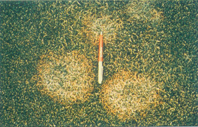
Fusarium Patch
Red Thread/Pink Patch
Poorly defined patches of bleached grass. Now thought to be 'complex' involving two species; L.fuciformis- produces pink mycelium in morning dew. Common on swards of low fertility, especially late summer and autumn, Fescues and Ryegrass particularly susceptible.
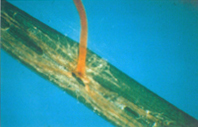
Red Thread/Pink Patch
Dollar Spot
This disease affects the Fescues - especially Creeping Red Fescue. It appears as small brown spots about 1-2 inches in diameter, which may occur in clusters affecting larger areas. The patches turn from brownish-yellow to brownish-grey.
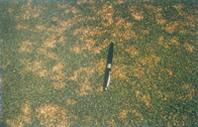
Dollar Spot
Grey Snow Mould
Areas of dead grass having a greyish appearance. Brown sclerotia up to 4mm in length can be seen embedded in the affected leaves. Appears only after prolonged snow cover. Most grasses are susceptible.
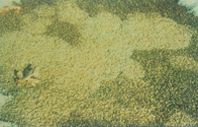
Grey Snow Mould
Brown Patch
Circular brown patches up to 3 feet in diameter. A characteristic greyish-black halo may be seen when the morning dew is present. Very rare. Occures during long, hot, dry spells.
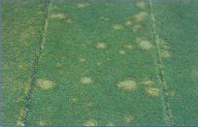
Brown Patch
Take-all Patch
Rings of yellow or orange grass 0.1-1.0m in diameter. The disease kills off the bents (Agrostis spp) leaving the centre of the ring populated with fescues and weeds. The disease can occur on all types of turf and is often induced by the practice of applying lime to neutralise an acid soil. It is also favoured by poor drainage
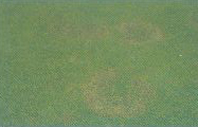
Take-all Patch
Leaf Spot/Melting Out
A disease which attachs Smooth-stalked Meadow-grass (Poa practensis). Symptoms are general browning and gradual disappearance of susceptible grasses. Individual grasses have brown or purple spots with straw-coloured centres. May be found in turf containing susceptible grasses at any time of year.
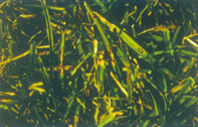
Leaf Spot/Melting Out
Fairy Rings
Toadstool producing fungi inhabit the soil 3"-18" below the grass. Various species divided into groups according to their effect on the turf"
Type 1 - Ring of dead grass bordered by darker green grass (illustrated)
Type 2 - Ring of darker green grass
Type 3 - Just a ring of toadstools
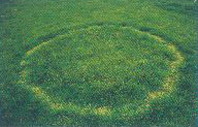
Fairy Rings
Anthracnose
Colletotrichum graminicola also known as basal rot of Annual Meadow-grass
Leaves of affected plants turn yellow. Youngest leaves often turn red. The plants rot at the base and can be pulled out with great ease. A black staining at the base of the plant an be seen when the disease is at the advance stage. Fairly common on poorly managed turf in late summer and autumn.
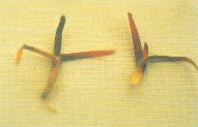
Anthracnose